In the digital age, a signature can feel impersonal. But in Chinese culture, there is a timeless and deeply artistic way to leave your mark: the seal, known as 印章 (yìnzhāng).
More than just a stamp, a seal is a piece of history, a work of art, and a powerful statement of identity, all carved in stone.

A History Etched in Stone
The history of seal carving, or 篆刻 (zhuànkè), dates back over 3,000 years to the Shang Dynasty. Initially used as a symbol of power and authority by emperors and officials, the art form evolved. Ancient seals were more than tools; they were tokens of trust. The phrase 盖印 (gài yìn), meaning "to affix a seal," was the final step that validated any important document, contract, or piece of art.
What is a Seal Made Of?
A traditional seal is a small object, typically carved from a durable material. Common materials include stone, such as the luxurious 鸡血石 (jīxuěshí) (Chicken Blood Stone) or the delicate 寿山石 (Shòushān shí). The bottom surface, known as the 印面 (yìnmiàn), is carved in reverse with characters. This surface is pressed into a thick, red paste called 印泥 (yìnní), and then stamped onto paper, leaving a beautiful crimson impression.
The Two Styles: Zhu Wen and Bai Wen
There are two primary styles of seal character carving, creating a striking visual contrast:
朱文 (zhū wén): This means "red characters." Here, the characters themselves are carved in relief, so they appear in red on the paper. This style feels elegant and delicate.
白文 (bái wén): This means "white characters." The background is left raised, and the characters are carved out. When stamped, the characters appear white against a red background, creating a bold and powerful effect.
More Than a Name
The content of a seal can be a person's name, often in the ancient 篆书 (zhuànshū) (Seal Script) font, or a studio name. However, many artists and scholars choose to carve a short, meaningful phrase or their personal 闲章 (xiánzhāng)—a "leisure seal." These express a personal motto, a philosophical belief, or a poetic sentiment, adding a deeper layer of meaning to a painting or calligraphy piece.
Today, owning a personal seal remains a cherished tradition. It connects the user to a profound cultural legacy. Having your own 印章 (yìnzhāng) is to hold a piece of art that is uniquely and authentically you.
|